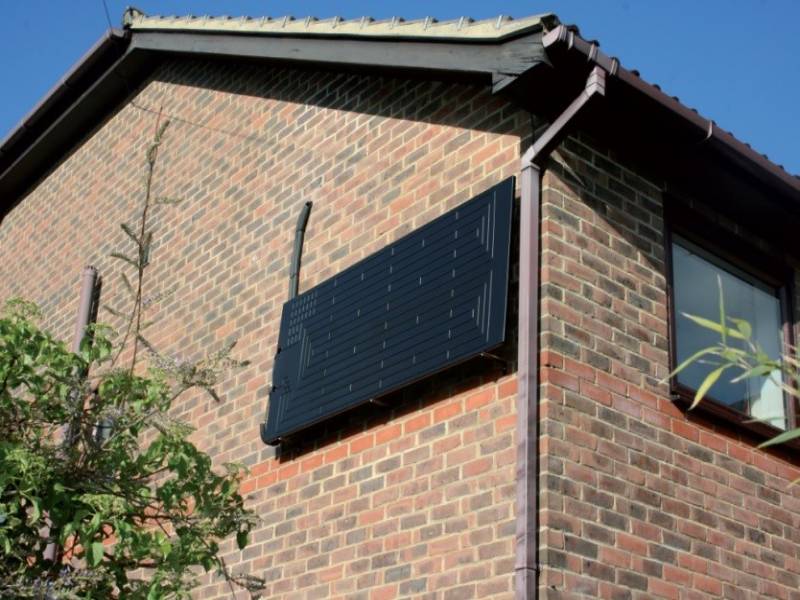Typically, when you think about solar panels, you picture solar photovoltaics (PV): panels that are installed atop your roof or in an open space and convert sunlight into electricity. However, solar panels can also be thermal, meaning that they convert sunlight into heat as opposed to electricity. Thermodynamic solar panels are one type of thermal solar panel–also called a collector–that differ dramatically from traditional thermal panels; instead of requiring direct sunlight, thermodynamic solar panels can also generate power from heat in the air.
Key takeaways
Thermodynamic solar panels can serve as the collector and evaporator in direct expansion solar-assisted heat pumps (SAHPs)
They absorb heat from both sunlight and ambient air, and typically don’t need direct sunlight, though they may not perform as well in colder climates
More testing is required to assess how well thermodynamic solar panels work in colder climates
While thermodynamic solar panels are most popular in Europe, some are starting to hit the market in the United States
How does a solar-assisted heat pump work?
SAHPs use thermal energy from the sun and heat pumps to produce heat. While you can configure these systems in many different ways, they always include five main components: collectors, an evaporator, a compressor, a thermal expansion valve, and a storage heat exchanging tank.
What are thermodynamic solar panels? How do they work?
Thermodynamic solar panels are components of some direct expansion solar-assisted heat pumps (SAHPs), where they serve as the collector, heating the cold refrigerant. In direct expansion SAHPs, they also serve as the evaporator: as refrigerant circulates directly through a thermodynamic solar panel and absorbs heat, it vaporizes, turning from a liquid into a gas. The gas then travels through a compressor where it’s pressurized, and finally to a storage heat exchanging tank, where it heats your water.
Unlike photovoltaics or traditional thermal solar panels, thermodynamic solar panels don’t need to be placed in full sunlight. They absorb heat from direct sunlight, but can also pull heat from ambient air. Thus, while thermodynamic solar panels are technically considered solar panels, they are in some ways more similar to air source heat pumps. Thermodynamic solar panels can be mounted to roofs or walls, in full sun or in complete shade–the caveat here is that if you live in a cold climate, they will probably operate most efficiently in full sunlight because the ambient air temperature may not be warm enough to meet your heating needs.
What about solar hot water?
Solar hot water systems use traditional collectors, which can either heat a refrigerant, like thermodynamic solar panels, or water directly. These collectors require full sunlight, and the refrigerant or water can move through the system either passively via gravity, or actively via a controller pump. SAHPs are more efficient because they include a compressor, which pressurizes and concentrates the heat in the gaseous refrigerant, and because they include a thermal exchange valve, which regulates the rate at which the refrigerant flows through the evaporator–which can be a thermodynamic solar panel–to maximize energy output.
How well do thermodynamic solar panels work?
Unlike solar hot water systems, thermodynamic solar panels are still a developing technology and are not as well-tested. In 2014, one independent laboratory, Narec Distributed Energy, conducted tests in Blyth, United Kingdom to determine the efficiency of thermodynamic solar panels. Blyth has a fairly temperate climate with heavy rainfall and the tests were run from January to July.
The results showed that the coefficient of performance, or COP, of the thermodynamic SAHP system was 2.2 (when you account for the heat lost from the heat exchanging tank). Heat pumps are typically considered highly efficient when they achieve COPs above 3.0. However, while this study demonstrated that, in 2014, thermodynamic solar panels weren’t highly efficient in a temperate climate, they can operate more efficiently in warmer climates. Additionally, as the technology has continued to advance, thermodynamic solar panels are probably in need of a new independent testing study.
How to evaluate the efficiency of solar-assisted heat pumps
Before choosing a SAHP, you should compare the Coefficient of Performance (COP) of various systems. COP is a measure of the efficiency of the heat pump based on the ratio of useful heat produced compared to its energy input. Higher COPs equate to more efficient SAHPs and lower operating costs. While the highest COP that any heat pump can achieve is 4.5, heat pumps with COPs above 3.0 are considered highly efficient.
Post time: Jul-19-2022






